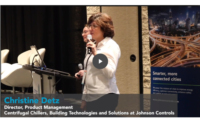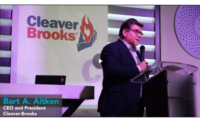During the 2020 AHR Expo in Orlando, Florida, Danfoss convened a briefing for members of the HVACR trade press to provide an update on the company’s business and the evolving regulatory landscape affecting industry as well as take a deeper dive into the impact of trends like electrification and district energy and the available technologies and solutions. This was the 25th year the company has hosted the event.
“2019 was a bit of a challenging year,” said John Galyen, president, Danfoss North America. “It was really characterized by growing uncertainty here and abroad. A trade war with China was particularly painful for the manufacturing sector. Danfoss’s organic sales in 2019 within the global group as well as here in North America were essentially flat with 2018 numbers.
“Specifically, the North American HVACR business actually started out pretty strong in 2019, but we lost some of that during the year. For 2020, we expect low single-digit sales growth with upside potential with further fiscal stimulus, reduced trade tensions and tariffs, and an improving global economy.”
Three Industry Trends
Galyen identified three major trends that are influencing and will continue to impact Danfoss’s operations. “While not a new trend, energy efficiency is the biggest contributor in reducing global warming, especially in the short term,” he said. “It is the low-hanging fruit, and we continue to invest in technologies and innovation to support our customers and industry in meeting this challenge.
“We are now also facing a global patchwork of refrigerants that will vary by application,” Galyen continued. “The conversion to low-GWP refrigerants will vary by region, country, and even state. And some of the new refrigerants are flammable. What’s most important is that we make a safe transition, respecting design, development, and test cycles — and considering the needs of our distributor and contractor partners.
“Electrification and decarbonization has been a prominent topic within the transportation sector, but we are seeing a trend to reduce the fossil-fuel combustion for heating in buildings and continued investment in renewable energy sources like wind and solar,” concluded Galyen. “In addition, some cities and states are considering a ban on fossil fuels in new construction—resulting in increasing interest in heat pump technology.”




